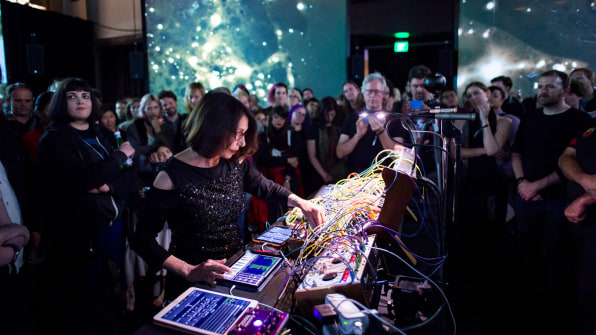
Fast Company, by Jay Woodruff on Oct 19, 2019.
Josette Melchor’s Gray Area blends art and tech to create social and civic impact.
Now occupying the former Grand Theater in the city’s Mission District, Gray Area continues to work at the intersection of art and technology to provide educational opportunities and studio spaces for residents in the increasingly gentrified neighborhoods of San Francisco. For example, Melchor’s organization helped raise $1.5 million for victims of the 2016 Oakland Ghost Ship fire.
Melchor, who identifies as “a community organizer, curator, entrepreneur, DJ, and queer Mexican woman,” helped launch an artist-in-residence program at Google and partnered with Autodesk to produce the Urban Prototyping Festival. She also launched the annual Gray Area Festival, which features experimental works from artists such as Thom Yorke, Sophie Kahn, and Taurin Barrera. Last summer, Gray Area hosted the exhibit Inferno, by artists Louis-Philippe Demers and Bill Vorn, where attendees donned robotic exoskeletons that made them dance. A few years ago, during the 2015 F.A.T. Gold San Francisco Exhibit (hosted and produced by Gray Area, sponsored by the National Endowment for the Arts, and curated by Lindsay Howard) the poop artist Katsu created a portrait of Eric Schmidt out of feces and called it “Eric Shit.”
“The reason it’s called Gray Area is that there’s really not a better way for us to describe artists using technology as a medium,” Melchor says. “There is a really big dichotomy between the two industries, and so Gray Area plays this role of cultural development and cross-sector collaboration and innovation.”
She says that she aims to use challenging art “to start conversations between artists and technologists criticizing the tech industry,” citing another part of the Gold San Francisco Exhibit, where F.A.T. Lab artists put up digital images of Facebook’s CEO outside the theater, emblazoned with the phrase “Rest in peace, Mark Zuckerberg.”
“People walking by thought we were throwing a Facebook event,” she says.
Melchor relishes being at the vanguard of community art and technology. As she notes, “There are not a lot of organizations that are set up to do that.”



